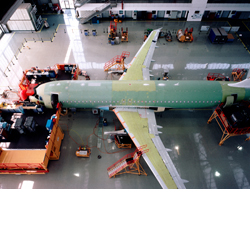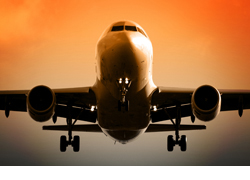 Every time you take a flight, you have an expectation that the airplane was manufactured and serviced using advanced, reliable and long-lasting materials. With an estimated two million passengers boarding more than 30,000 flights daily in the U.S., you are not alone with that expectation.1 Aliphatic diisocyanates are often used as a key component in the production of paint and coatings that help protect aircraft from harsh conditions.
Every time you take a flight, you have an expectation that the airplane was manufactured and serviced using advanced, reliable and long-lasting materials. With an estimated two million passengers boarding more than 30,000 flights daily in the U.S., you are not alone with that expectation.1 Aliphatic diisocyanates are often used as a key component in the production of paint and coatings that help protect aircraft from harsh conditions.
How Do Aliphatic Diisocyanates Contribute?
There are a variety paint and coatings technologies used to meet stringent requirements for aircraft production and maintenance. Some of these coatings technologies rely on aliphatic diisocyanate (ADI) products as a key component. ADIs are used in the production of specialized polyurethane coatings which represent an important material for the aerospace industry, among others. When applied to aircraft, here some of the main benefits that ADI-based polyurethane coatings provide:
- Exceptional durability and resistance to ultraviolet (UV) light and weathering.
- Help protect against corrosion by retarding oxidation and etching of the aluminum skin and fasteners, thereby prolonging aircraft life.
- Excellent balance between hardness and flexibility, which gives coatings manufacturers a range of formulation options to meet various airline specifications.
- Outstanding chemical resistance, which can help extend coating life. This is important for aircraft coatings where hydraulic fluid and other chemicals may be used.
These properties are made possible by ADI chemistry, which enables formulators of aircraft coatings to continue product advancements.
Aircraft Coatings: A Vital Role Economically and Environmentally
 According to the Federal Aviation Administration (FAA), the total number of aircraft in the U.S. commercial airline fleet (including regional carriers) stood at over 7,100 at the end of 2011.2 These aircraft are maintained to the highest standards set by government agencies—and this includes routine inspection and maintenance of their protective coatings. The aircraft coatings industry overall is an important contributor to the economy and was valued at roughly $140 million in 2008, according to Chemark Consulting.3
According to the Federal Aviation Administration (FAA), the total number of aircraft in the U.S. commercial airline fleet (including regional carriers) stood at over 7,100 at the end of 2011.2 These aircraft are maintained to the highest standards set by government agencies—and this includes routine inspection and maintenance of their protective coatings. The aircraft coatings industry overall is an important contributor to the economy and was valued at roughly $140 million in 2008, according to Chemark Consulting.3
The aerospace industry expects coatings suppliers to develop products that reduce application times, improve performance and increase durability. According to the International Air Transport Association (IATA), new technology in aerospace coatings can minimize drag in the air and help reduce debris build-up, both of which reduce airplane fuel consumption, and thereby, carbon footprint. Such savings have both an economic and environmental impact that cannot be understated: a one percent improvement in fuel efficiency in the aviation industry can lower fuel costs by $700 million a year. On average, airlines incur about $100 a minute per flight in operating costs. Therefore, even saving just one minute of flight time could reduce total operating costs by more than $1 billion a year and significantly reduce environmental emissions.4
Many of the new coating innovations are focused on helping airlines become more cost effective. For example, to reduce the amount of time it takes for aircraft to undergo maintenance, new coatings systems have been developed that allow for faster application and drying of exterior top-coat applications. As another example, conventional aerospace coatings have historically been based on two-component polyurethane coatings that typically require 72 hours to cure (fully develop their physical properties). Some coatings producers have developed coatings formulations that use ultraviolet A (UVA) light to significantly accelerate the curing process. This enables airplanes undergoing topcoat refurbishing to get back into service faster. A faster turnaround for aircraft maintenance can enhance scheduling flexibility and ultimately help reduce costs.
Aerospace coatings technologies are continually being developed to help reduce environmental impact. Some examples include waterborne structural coatings and products with lower volatile organic compound (VOC), chrome and/or lead content.
Aliphatic Diisocyanates Chemistry Takes Flight
With rising fuel costs and a focus on cost effectiveness, airlines around the world seek products that continually help improve aircraft efficiency, reliability, and safety. This applies not only to commercial aircraft, but to military and private aircraft as well. Clearly, aliphatic diisocyanates continue to play an enabling role in the aerospace industry and are “flying high” in coatings formulations worldwide.
1 New York Times, February 11, 2013, Airline Industry at Its Safest Since the Dawn of the Jet Age. http://www.nytimes.com/2013/02/12/business/2012-was-the-safest-year-for-airlines-globally-since-1945.html?pagewanted=all&_r=1&
2 FAA statistics reported in Air Transport World (ATW), March 2012: http://atwonline.com/aircraft-amp-engines/faa-us-commercial-aircraft-fleet-shrank-2011
3 Coatings World: August 2010, http://www.coatingsworld.com/issues/2010-08/view_features/aerospace-coatings-2010-08-02-00-00-00/
4 IATA: cited by the American Coatings Association: http://www.paint.org/about-aca/item/532.html#aerospace